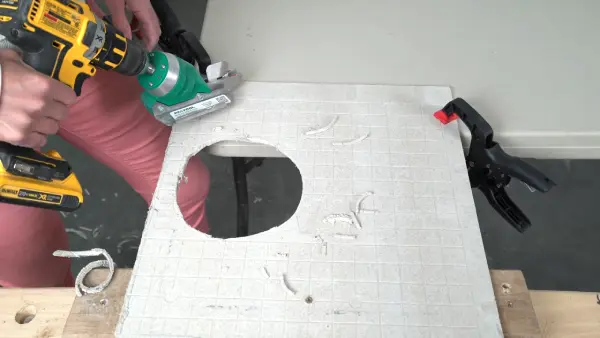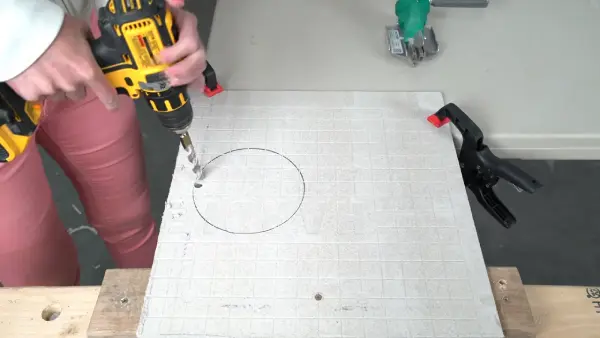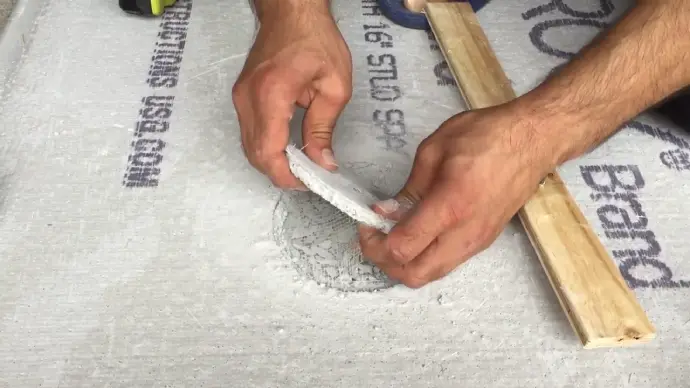Last Updated on September 13, 2023
Cement board is a popular building material with excellent durability and strength, making it ideal for use in bathrooms, kitchens, and outdoor spaces. They can easily withstand high-moisture environments thanks to their unique cement, sand, and reinforcing fiber composition.
One of the most significant challenges of installing cement boards is cutting holes to fit fixtures such as pipes, faucets, and electrical outlets. Fortunately, there are ways to make this daunting task much easier.
Using tools like a board Scoring Knife and Scoring and Snapping methods, you can precisely make holes in the cement board without compromising its integrity.
So, don’t let cutting holes in cement boards scare you. This easy guide informs how to make a hole in the cement board.
How to Cut a Hole In Cement Board: Easy Methods
Cutting a hole in a cement board can be daunting, but it can be done effectively and efficiently with the right tools and techniques.
Here are some methods for cutting a hole in cement board:
ONE: Using a Board Scoring Knife

This discussion will focus on using a board-scoring knife to cut holes in cement boards. The process involves:
Step 1: Mark the Desired Location
Before creating a circular incision on a cement surface, accurately mark the desired location using a pencil or marker. This step is essential in ensuring that the cut is made in the correct spot.
To avoid mistakes, take time to be precise when marking. This will also help the person making the incision stay within the designated area, resulting in a smooth and even cut.
Step 2: Position and Start Boring the Hole
To create a circular incision on cement, position the board scoring knife precisely and apply pressure while rotating it in a circular motion. The groove created should be approximately 1/8 inch deep.
When cutting holes in the cement board, use the pointed edge of the scoring knife and ensure it is perpendicular to the board to avoid damage or uneven cuts. Apply pressure gradually and consistently to avoid mistakes.
Step 3: Bore Out the Circle
Use the scoring knife to widen the groove made in the previous step. Gradually apply pressure while rotating the knife until a complete circle is formed. Keep the circular motion and consistent pressure to ensure the cement board is cut through.
Remember to use the scoring knife carefully and safely, as it can be dangerous. Practice and attention to detail will lead to a perfect circle.
Step 4: Turn the Scoring Knife Around
Flip the scoring knife and use the other pointed edge for a larger aperture in the durable substrate, especially for cement board holes. Be cautious when using the sharp scoring knife, and wear protective gear to avoid injury.
Step 5: Repeat the Process
Now that the scoring knife has been turned around, you must repeat the previous steps to make the hole. Keep applying pressure and use a circular motion as you continue to bore through the board.
Remember to be patient and precise, ensuring you achieve the desired size without damaging the blade by avoiding forcing the knife.
Step 6: Check the Hole Size & Clean Op
Check the size of the hole and clean up. Use a brush or cloth to thoroughly clean the area and prepare it for the next step. Remember, checking the hole size and cleaning up are crucial final steps in making cement board holes.
TWO: Scoring and Snapping

Cutting holes in cement board is also easy with the score and snap method. This technique involves:
Step 1: Prepare for Cutting
Before cutting into a cement board, it’s important to prepare properly. Getting started is measuring and marking the desired dimensions on the material surface. Ensure accurate measurements and clear markings to avoid mistakes that could impact the final outcome.
Once marked, place the cement board on a secure surface to avoid breakage or damage during cutting. The cement board is hard and brittle, making it easier to cut and shape with proper tools and techniques. Taking the time to prepare carefully is crucial.
Step 2: Score the Cement Board
To create an opening in the cement board, Score along the marked cutting line with a scoring tool and a straight edge secured with clamps. Apply even pressure while firmly and steadily scoring to create a deep, clean groove.
It’s important to score the cement board deeply enough for a clean cut without causing damage. To ensure a precise scoreline for a perfect fit, experience and accuracy are crucial. It takes focus and a steady hand to avoid damaging the cement board.
Step 3: Breaking and Trimming
Now that you’ve scored the cement board, it’s time to break and trim it. Use pliers instead of garden shears for better control and accuracy, especially if cutting narrow strips without leverage. Grasp the scored section with the pliers and carefully apply pressure to snap it along the score line.
This step is crucial for achieving clean and accurate cuts, especially for projects with straight edges or precise measurements. However, be careful not to break the board in the wrong place or damage the surrounding area.
Step 4: Clean Cuts and Section Removal
Cutting the cement board with precision and clean cuts is essential for a successful job. You’ll need a hammer and a screw to break off the desired section along the scored line to do this. Tap the scored line with the hammer and screw until the section is separated.
Remember to be patient and gentle to avoid damaging the surrounding area. Once the section is removed, use a utility knife or sandpaper to trim any rough edges for a smooth finish.
Is it possible to drill a hole in the cement board?

You can drill holes in cement boards with a carbide drill bit. Utilizing a carbide drill bit for drilling holes in cement boards presents a much more convenient option than traditional steel drill bits. This technique permits the drilling of cement-fiber siding at the installation site or before.
It does require patience and expertise, so use a variable-speed drill and start slowly to avoid damage. While drilling, wear protective gear like eye goggles and a mask to prevent inhaling dust or debris.
Is hiring a professional to cut holes in the cement board necessary?
While drilling cement board holes is possible, doing so without proper knowledge can lead to problems. Which is why hiring a professional is recommended.
Even so, hiring a professional is unnecessary if you know how to cut cement board holes properly. Cutting requires caution and precision to avoid damaging the board or creating rough edges that can cause injuries later.
As such, having the necessary knowledge and skills to execute the cutting process properly is important. You’re better off hiring a professional if you don’t have the necessary expertise.
Construction Projects: Cutting Holes in Cement Boards
When installing pipes, wires, and fixtures, cutting holes in cement boards is necessary during construction projects. While drilling is an option, it’s only sometimes effective due to the cement board’s density and weight. Instead, use a jigsaw or circular saw with a diamond blade.
Wear protective gear like goggles and dust masks to prevent injury or exposure to silica dust, a leading cause of respiratory diseases. Hiring a professional may be beneficial for larger or more complex projects. Although, smaller DIY projects can be easily accomplished with proper tools, precautions, and knowledge.



